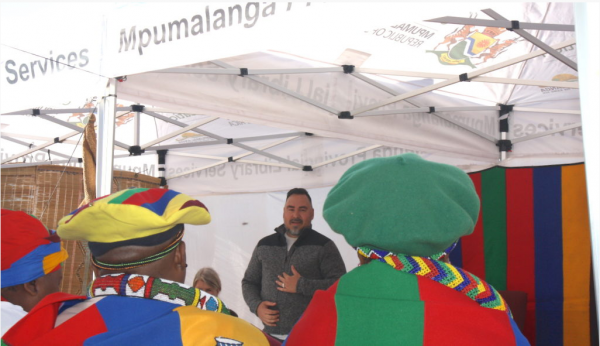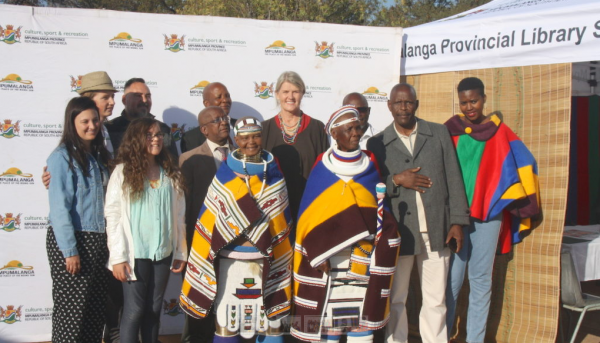By Jeff Dodge Originally posted on Source

A recent graduate of Colorado State University and her faculty mentor played a key role in creating an exhibition of female African artists that has moved from CSU’s Gregory Allicar Museum of Art to a museum in South Africa.
The effort to shine a light on work by largely unheralded artists was a collaboration involving Dave Riep, an associate professor in the Department of Art and Art History, and Laura Vilaret-Tuma, who graduated from CSU in 2018 with an undergraduate degree in art history.
For more than 15 years, Riep has researched the culture of the South Sotho people in South Africa, leading study abroad trips, helping restore a small museum there that had been vandalized, hosting an Allicar exhibition of African beer vessels and having his students create a South Sotho mural outside CSU’s Visual Arts Building.
About the exhibition
Riep said the new collaboration with the Kghodwana Cultural Village and Museum in Mpumalanga, South Africa, was an outgrowth of CSU’s longtime relationship with the nonprofit Africa Meets Africa and its director, Helene Smuts. Riep, Smuts and Kghodwana Chief Curator Petrus Mahlangu realized a couple of years ago that the Allicar and the South African museum had similar pieces, some of which were created by the same women from South Africa and Kenya. The art, primarily consisting of pottery, beadwork and mural painting, had historically been seen as “women’s work,” which elicited the name of the traveling exhibition: “Women’s Work: Art and Sustainability in Contemporary Southeast Africa.”
Riep said it’s rare to have an exhibition appear in both the United States and Africa, since it’s expensive to ship items overseas and care for them in a different environment. So he, Vilaret-Tuma, Mahlangu and Smuts came up with a new concept: Print portraits of the artist with accompanying text on vinyl panels that could easily be rolled up and transported from CSU to South Africa. The panels were then used to accompany pieces in each museum’s collection created by the featured artist. The text on the panels appears in both English and Isindebele, the native language of the Ndebele culture. Vilaret-Tuma even translated it into Spanish for the Allicar exhibition, which was on display from Oct. 5 through Dec. 14 last year.

Opening ceremony
This summer, Riep took the 18 panels to the South African museum, where the exhibition was heralded with much fanfare, as kings, chiefs and government officials in the area attended an opening ceremony in June that was covered by the national television station, the South African Broadcasting Corporation, and local newspapers. The exhibition was organized in partnership with the country’s Department of Culture, Sports and Recreation.
“So we were able to avoid the cost of transporting the actual pieces,” Riep said, adding that writing the text was a joint effort. “Some of the text was provided by the artists themselves, since we wanted them to have their own voice with their art, rather than that of a Western scholar.”
“We really placed an emphasis on collaboration,” Vilaret-Tuma added. “We had a lot of hands in the pot, which was cool. We each put our own knowledge and experience into the exhibition.”
The artists
One of the artists whose work is owned by both museums and is part of the exhibition is Esther Mahlangu, who teamed up with recording artist John Legend in 2016 to fight AIDS. Mahlangu’s artwork appeared on special bottles of Belvedere Vodka as part of a (RED) campaign led by Legend, and half of the proceeds from those bottles went toward the fight against HIV/AIDS in Africa.
“She’s a major player in African art,” Vilaret-Tuma said.
Two of the artists, Sophy Mahlangu and Esther Mnguni, attended the opening ceremony in June alongside Riep, Smuts, Petrus Mahlangu and Bonginkosi Mtsweni of the Department of Culture, Sports and Recreation.
Vilaret-Tuma said the research skills she learned at CSU were key to her involvement in the project.
“I love doing research,” she said. “The more I can contribute to the research and dialogue of African arts within the art history canon, the better. I’m so glad I got to continue working on this project after graduation.”
The Department of Art and Art History is part of CSU’s College of Liberal Arts.